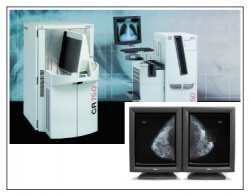Integration for comprehensive solutions
Marcus Ostländer, Radiology Solutions Business Manager, Europe, outlines the innovations and strategies of the AGFA HealthCare Division in an EH interview at the RSNA

The Agfa HealthCare Division’s motto in 2004 became Inspire, Transform, Achieve, and the visual presentation at the RSNA, emphasised that IT and high-tech are at the centre of the firm’s healthcare business, Marcus Ostländer pointed out: ‘You won’t find any films at this exhibition stand. Our strategic orientation is towards the Solution Business, and our hospital-wide IT solutions cover not only radiology but also many other medical fields, such as mammography, cardiology and orthopaedics. We are not looking at individual products but at integrations into comprehensive solutions.
‘In Computed Radiography we have two new systems, the CR 25, a single-plate-CR system, and the CR 75, a multi-plate system, and both can also be used for mammography images. This is important for radiologists, because CR in mammography is currently a very hot topic in Europe. We also have the brand new CR50, a computed radiography system with the kind of picture quality previously only achievable with DR. So, we have combined the flexibility of the CR system with the image quality of DR equipment.
‘The next most important topics in radiology are PACS and RIS,’ he continued. ‘The flagship of the market, our IMPAX ES - Enterprise Suite - comprises integrated PACS/RIS diagnosis solutions for radiology in general, but also for mammography in particular, including CAD. We also offer IMPAX solutions for cardiology and orthopaedics, which can be integrated into the entire hospital concept. This includes appointment planning across a hospital and, of course, the integration of images with electronic patient records (EPR).
‘Our next generation IMPAX is being shown as a work in progress. One highlight of this further development is the so-called persona-based design. Our teams of experts have analysed how many users work in different situations in a hospital and established different user types, so-called personas, from that analysis. These personas can be radiologists, clinicians, X-ray technicians or systems administrators, and they all have different requirements regarding specifications for visualisation and context of images, patient, department and systems information. We are not talking about special work stations for certain applications - every IMPAX user is given a customised desktop, depending on their personal profile, which makes the system very flexible and efficient. This can be within the hospital or also for access from remote locations, with transmission via intra or extranet. Our user-management is flexible in terms of system maintenance, the creation of user groups, user profiles and the distribution of access rights for users, particularly in academia, where many students also work. We combine utmost compliance with the requirements for security and access to patient data with simple, flexible administration. For instance, system administrators can check it over from any location in the hospital, and set up users and adapt profiles.’
Asked about new developments innovations in fields other than radiology, Marcus Ostländer mentioned orthopaedics. ‘We have taken components from the IMPAX environment for support in the choice of implants in a filmless environment. For example, the procedure to replace a hip joint with implants used to be carried out by taking an X-ray and then trying out as many different templates on the X-ray as it took to find the right prosthesis. In a world without film we now have elegant digital solutions for this problem. X-ray films are no longer being used here - the image is called up at a special IMPAX orthopaedics workstation where the surgeon can choose from over 12,000 implants for different uses, including screws and nails. Digital superimposition facilitates finding the ideal implant and planning the operation, with the plan made available through web-based image distribution in the operating theatre. This has been in use since the beginning of 2004, and we have now extended that solution with a so-called trauma package - particularly suitable for treating multi-trauma patients. For example, the system provides a choice of screws for fixing fractures and suggests how they can best be used.’
In terms of networks and projects, Marcus Ostländer said the firm is looking at the healthcare services, and particularly those that support the successful implementation of PACS/RIS projects. ‘This begins with project analysis, which determines how the workflow functions, what the configurations look like and what changes are to be expected for the workflows,’ he pointed out.
But what does the term health services mean in this context: where do they begin, end, or overlap?
‘A good question,’ he replied, ‘seeing how radiology is obviously integrated into all processes in the hospital. Initially we are talking about services that are required for the digitisation of a hospital. At this stage, we also act as consultants, asking how a hospital works, how the radiology department works, where are the interfaces with the clinicians, what is the workflow like and what should it be like, and what are the objectives that we are trying to achieve through digitisation. However, these services do certainly also comprise technical solutions.
‘Our Solutions Monitoring and Management Services (SMMS) can constantly monitor the activities of the entire digital network and its connected components. This can then provide us with statistics on the volume of data, systems capacity and utilisation - information usually required by senior radiologists, who need to know what’s happening in the department, how workstations are being used and what capacities are like. Hospital administrators also require that information, to know what the workloads and utilisation of equipment are like and what trends can be seen with the data volume. The system can provide short-term analyses or determine long-term trends.
Another important feature is pro-active remote diagnosis and maintenance, which practically prevents system down times, because corrective or error-preventing measures can be taken before the user even notices an error. In other words, you have extremely high stability with this system.’
Where would this control unit be based? ‘Think of it less as a physical component but more as an intelligent software solution that can be used, for instance, by a systems administrator with appropriate access, who is then provided with all the information and statistics and who can carry out remote diagnosis and maintenance through communication with the AGFA service network via secure gateways.
Moving on to the subject of cardiology, Marcus Ostländer said the firm has entered into a co-development with Heartlab ‘... a very renowned and successful provider of cardiology information management systems in North America. They develop planning, diagnosis- and structured reporting systems. Just like radiology, cardiology uses data from different imaging modalities, and this data from different systems, e.g. MRI, ultrasound and ECG, must come together. Our new system, which is integrated into the design of the Impax environment, facilitates this.’
Mammography was the last topic to be discussed, and we asked about the firm’s current competitive role in this field, to which he replied: ‘We have a digital diagnostics station, the MA3000, which is part of the Impax range and developed especially for women’s care, i.e. the workstation was developed for mammography images diagnoses. It automatically supports the special requirements for imaging formatting and positioning, as well as the indication of results for possible CAD processing. Apart from CR systems used in mammography we also offer digital direct-mammography - a particularly exciting area because, although there has been a lot of digitisation, mammography is the last area that, in most cases, is still done in the analogue format.
‘The high image quality of digital mammography - both CR and DR- has been documented. But the real point is that the digitisation of mammography will allow complete digitisation of radiology as a whole. Conventional X-rays will be replaced by CR systems. The end result will be a digital image. However, mammography currently still works with films. So if you have to keep the film processing side going exclusively for mammography, switching to a digital system is a very attractive prospect. Screening programmes, which are currently the subject of much discussion, require high capacity and fast availability of images. We have a digital mammography solution that is complemented by the appropriate diagnostics station, which, in turn, is integrated into the Impax environment.’
08.08.2006











